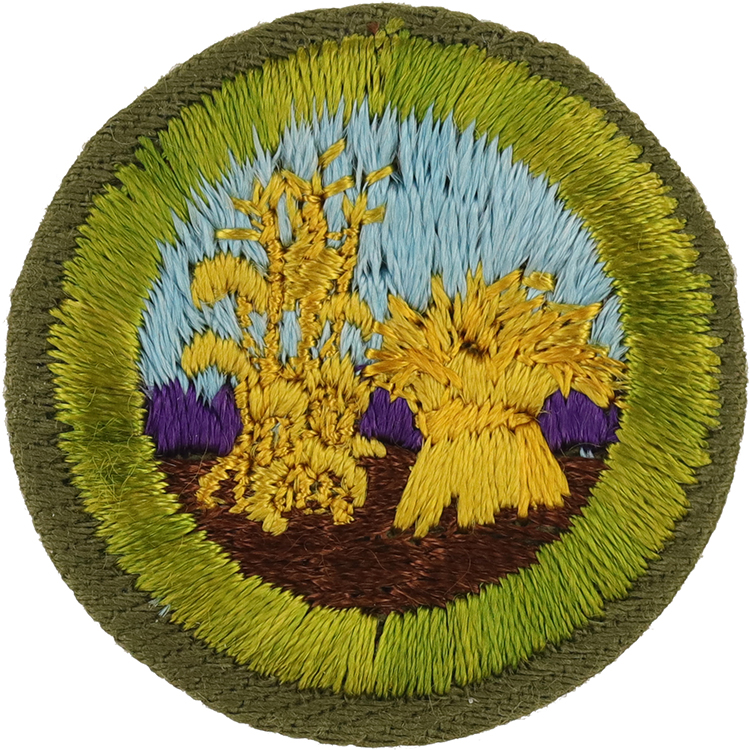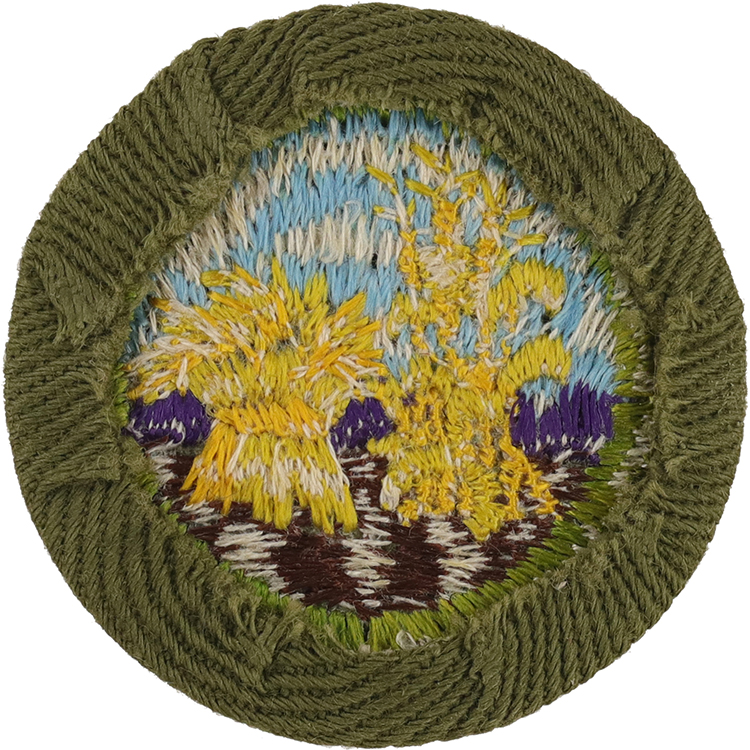
Fig. 1: SmaCer-E2-Front
- Cloth: Khaki right twill
- Embroidery: Cotton lock stitch

Fig. 2: SmaCer-E2-Reverse
- Back: Plain NO imprint with starch
Item Name: Small Grains & Cereal Foods 1941 - 1958
Item ID: SmaCer-E2
Collector Rating: 1
Pamphlets Used to Earn this Badge
Requirements December 1941 until June 1948
To obtain this Merit Badge, a Scout must meet four of the eight requirements in each of Parts I and II ( or a total of eight of the sixteen requirements) PART I (Four of the eight requirements which follow including requirement No. 2)
1. Gather and show bottle samples of at least five of the small grains grown in his state or section.
2. Make a seed tester and conduct a germination seed test of 100 small grain seeds.
3. Explain and show by use of soil, two methods of preventing soil erosion in growing small grains.
4. Gather and show samples of three small grain plants, showing root system, stock, leaves and seeds.
5. Explain and demonstrate in an outdoor seed-bed or large box filled with soil the preparation of a seed-bed and show how to plant wheat and oats or any two small grains native to his section.
6. Prepare exhibit samples for county or state fair by the use of three small grains grown in his section. (Judging requirements by use of pure seed standards.)
7. Grade wheat and oats into three commercial grades as used in his state and national markets.
8. Operate a grain drill and demonstrate how to adjust the drill for planting different sized grains.
PART II (Any four of the eight requirements which follow:)
1. Show samples of five small grain products other than food and indicate crop from which each is made.
2. Prepare an exhibit of four cereal crops and show in each case the grain and the food cereals manufactured therefrom.
3. Go to his grocery store and list all food products known as cereal foods; give package name of each, name of small grain from which it is manufactured.
4. Give the manufacturing processes of corn flakes, rolled oats, and puffed wheat, rice, etc.
5. Prepare a hot cereal in camp or at home, such as oatmeal, wheatcakes, etc.
6. On map of United States, indicate the areas where small grains are grown extensively. Locate especially wheat, rice, oats, barley and flax areas.
7. To what extent do other countries grow small grains including sorghum. Explain fully.
8. What are the food values of cereal foods? Explain fully.
OR
As a substitute for Parts I and II above, a Scout may comply with the standard 4-H Club or Home Project requirements in small grains and cereal crops, as follows:
1. Manage or operate a grain project for season or year, as required by your leaders.
2. Do all work and keep cost accounting records, as required by your project leaders.
3. Make a community, county, or state fair exhibit of grains you have produced.
4. Make a report of your work as required, and have it approved by your 4-H or Home Project Leader.
Requirements June 1948 until January 1957
PART I
(Four of the eight requirements which follow including Requirement No. 2.)
1. Gather and show bottle samples of at least five of the small grains grown in your state or section.
2. Make a seed tester and conduct a germination seed test of 100 small grain seeds.
3. Explain and show by use of soil, two methods of preventing soil erosion in growing small grains.
4. Gather and show samples of three small grain plants, showing root system, stock, leaves and seeds.
5. Explain and demonstrate in an outdoor seed-bed or large box filled with soil the preparation of a seed-bed and show how to plant wheat and oats or any two small grains native to your section.
6. Prepare exhibit samples for county or state fair by the use of three small grains grown in your section. (Judging requirements by use of pure seed standards.)
7. Grade wheat and oats into three commercial grades as used in your state and national markets.
8. Operate a grain drill and demonstrate how to adjust the drill for planting different sized grains.
PART II
(Any four of the eight requirements which follow:)
1. Show samples of five small grain products other than food and indicate crop from which each is made.
2. Prepare an exhibit of four cereal crops and show in each case the grain and the food cereals manufactured therefrom.
3. Go to your grocery store and list all food products known as cereal foods; give package name of each name of small grain from which it is manufactured.
4. Give the manufacturing processes of corn flakes, rolled oats, and puffed wheat, rice, etc.
5. Prepare a hot cereal in camp or at home, such as oatmeal, wheatcakes, etc.
6. On map of United States, indicate the areas where small grains are grown extensively. Locate especially wheat, rice, oats, barley and flax areas.
7. Explain fully to what extent other countries grow small grains including sorghum.
8. Explain fully what are the food values of cereal foods.
OR
Comply with the 4-H Club or Home Project Requirements in small grains and cereal crops.
Requirements January 1957 until November 1959.
Qualify in all of the following:
1. On a map of the United States show where the following crops are grown in volume: rye, oats, barley, wheat, rice, flax, corn, soybeans, sorghum.
2. Run a germination test of 100 seeds each for two of the above crops raised in your area. Tell how you would treat these seeds to control disease.
3. Submit a sketch of a field on which grain is to be grown, showing how you would control soil erosion. Describe crop rotation, strip farming and contour farming.
4. Demonstrate in an outdoor seedbed or large box filled with soil the preparation of a seedbed and plant wheat and oats or any two small grains native to your section.
5. Explain steps farmers take to protect crops from diseases and insects and stored crops from rodents.
6. Make an exhibit of three or more grain crops and display at a school, fair, or Scouting event. Must include root systems, stems, leaves, and seeds.
And qualify in any three of the following:
7. Collect, bottle, and label samples of three grain seeds grown in your area. Mark on label the variety, where grown, and the number of days from planting to harvest.
8. Do a soil conservation project; describe how it was done and give the results.
9. For two grains grown in your area, explain how you would prepare the field. Give dates and methods of planting and the amount of seed per acre; define "certified" seed.
10. Assist in harvesting a crop of grain; describe a combine and how it works.
11. Visit a grain elevator, a seed sales plant, or a grain marketing center. Take notes and write an acceptable article on what you learned.
12. Visit your grocery store and list the grain products sold; describe how one of these products is manufactured.
13. Prepare and serve a hot cereal food at home or camp; describe protein and other food ingredients in cereal and grain products and tell how they contribute to health.
* As a 4-H'er, complete a club project in this subject. Or as an FFA member, meet these or equivalent requirements through the FFA supervised farming program.

